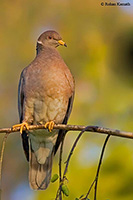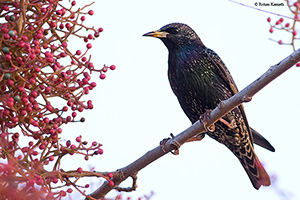Who Incubates? |
|
|---|---|


photographs of a Band-tailed Pigeon and a European Starling by Rohan Kamath |
Which
parent incubates varies greatly among species, as we
indicate in the species treatments. In most birds, parents
share incubation. Double-crested Cormorants, like many other
birds that share the task, relieve each other regularly,
every hour or so. In other birds, including some sandpipers,
pigeons, and doves, the female incubates at night while the
male takes his turn during "working hours" -- about 9 A.M to
5 P.M. Both sexes of most woodpeckers alternate during the
day, but the male sits on the eggs at night. Starlings, on
the other hand, share the task during the day, but the
female alone incubates at night. In monogamous species in
which both adults incubate the same clutch, the eggs usually
are covered most of the time. That is the case in the
African Common Waxbill, an estrildid finch, one of the most
extreme examples of shared incubation: in this species the
pair spends virtually full time sitting together on the
clutch. The female is the only incubator in hummingbirds, many raptors, many passerines, and all North American polygynous species (those in which one male has more than one mate). Often the male is not without duties; he may feed the incubating female and stand watch from a nearby perch. Female hornbills, brightly colored Old World birds with large, down-curved bills, lay their eggs in cavities. The female then seals herself into the cavity with the eggs, using first mud and then feces mixed with food remains (in some species the male helps make the seal), leaving only a narrow vertical slot through which the male passes her food. Males of some hornbill species |
| feed the female throughout incubation and raising of the
young; in others the female breaks out when the young are
partially grown and helps with the feeding
chores.In polyandrous birds (those
in which one female mates with more than one male), like
jacanas and phalaropes, it is common for the male to be the
sole incubator. Polyandry is relatively rare, though, and in
only about 5 percent of bird species do males do all the
incubating. In certain polyandrous shorebirds, such as
Spotted Sandpipers and Temminck's Stints, the female lays
more than one clutch. She then incubates the clutch in one
nest, and her mates incubate those in others. In the remaining 20 percent or so of bird species the pattern is variable, with one or both sexes incubating according to circumstances. What controls the distribution of the incubation task is not thoroughly understood, but ecological factors such as distance to food supplies, climate, and predation pressures must all play roles. For example, seabirds that must travel long distances to feed, clearly cannot leave all of the incubation chores to a single parent. |
|
| SEE:
Incubation: Heating Eggs;
Incubation Time;
Hatching Asynchrony and Brood Reduction. Copyright ® 1988 by Paul R. Ehrlich, David S. Dobkin, and Darryl Wheye. |
|